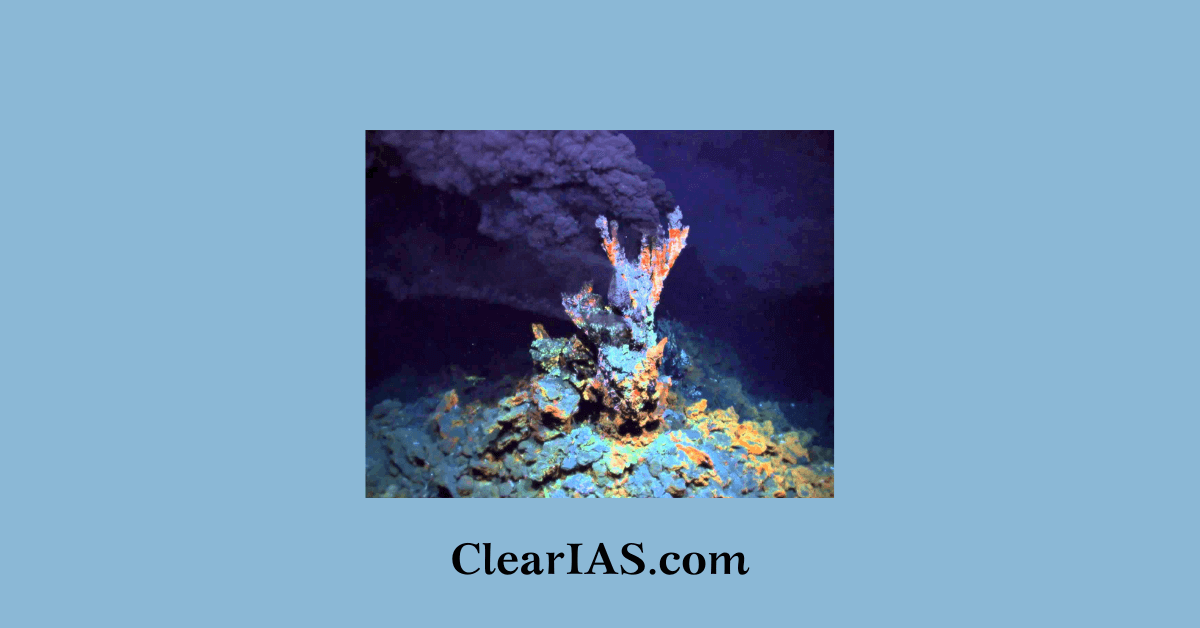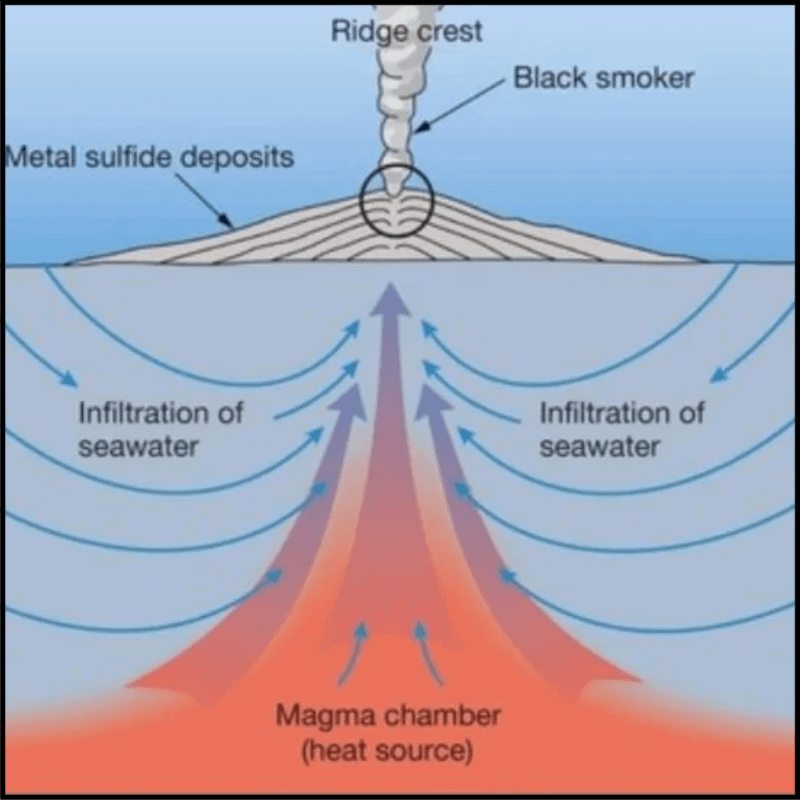
Hydrothermal vents are unique geological formations found on the ocean floor, where geothermally heated water is expelled through fissures in the Earth’s crust. These vents play a critical role in marine ecosystems, biogeochemical cycles, and even hypotheses about the origin of life on Earth. Read here to learn more.
The identification of an active hydrothermal vent 4,500 meters beneath the Indian Ocean marks a significant milestone in India’s deep-sea exploration efforts, especially as part of the Rs 4,000-crore Deep Ocean Mission initiated by the Ministry of Earth Sciences.
What Are Hydrothermal Vents?
Hydrothermal vents are underwater hot springs formed when cold seawater interacts with magma beneath the Earth’s crust.
They are primarily located in tectonically active regions near mid-ocean ridges where Earth’s tectonic plates diverge.
Formation Process:
- Cold Water Infiltration: Seawater (~2°C) penetrates through cracks in the ocean crust.
- Heating by Magma: The water comes into contact with magma, heating up to extreme temperatures (~370°C).
- Mineral-Rich Plumes: Heated water, now rich in dissolved minerals and gases, is expelled through vents and chimneys, forming plumes.
Types of Hydrothermal Vents

- Black Smokers
- Emit dark-coloured plumes rich in iron sulfides.
- Typically form tall chimney-like structures.
- White Smokers
- Emit lighter-coloured plumes due to the presence of barium, calcium, and silicon.
- Usually found at lower temperatures than black smokers.
- Diffuse Flow Vents
- Release warm, mineral-rich water without forming chimneys.
- Found around black and white smokers, supporting unique ecosystems.
Ecosystems Around Hydrothermal Vents
Hydrothermal vents host unique, thriving ecosystems, despite extreme conditions like high pressure, darkness, and toxic chemicals.
- Chemosynthesis-Based Life: Unlike most ecosystems that rely on sunlight, vent ecosystems depend on chemosynthesis, where bacteria convert hydrogen sulfide into energy.
- Key Species
- Tube Worms: Symbiotic relationships with chemosynthetic bacteria.
- Vent Crabs and Shrimp: Feed on bacteria and other organisms.
- Giant Clams and Mussels: Harbor symbiotic bacteria in their tissues.
- Biodiversity Hotspots: Vent ecosystems are rich in biodiversity, with many species endemic to these environments.
Other geothermal features
Below are geothermal features similar to hydrothermal vents and their characteristics:
- Geysers
- Geysers are hot springs that periodically erupt, expelling water and steam into the air.
- Similarities to Hydrothermal Vents:
- Both involve superheated water heated by magma beneath the Earth’s crust.
- Pressure buildup due to confined water leads to explosive releases.
- Support unique microbial life forms adapted to extreme temperatures.
- Example: Old Faithful in Yellowstone National Park, USA.
- Hot Springs
- Natural pools of geothermally heated water at the Earth’s surface.
- Similarities to Hydrothermal Vents:
- Both are sites where heated water emerges due to geothermal activity.
- Rich in minerals dissolved from underground rock layers, influencing their chemistry.
- Some hot springs harbour thermophilic microorganisms akin to those found in hydrothermal vents.
- Example: Blue Lagoon, Iceland.
- Fumaroles
- Openings in the Earth’s surface that emit steam and gases like carbon dioxide, sulfur dioxide, and hydrogen sulfide.
- Similarities to Hydrothermal Vents:
- Both release gases from the Earth’s interior due to volcanic or geothermal activity.
- Fumaroles can occur in deep-sea environments, closely resembling hydrothermal vent activity.
- Example: Valley of Ten Thousand Smokes, Alaska, USA.
- Mud Pots
- Acidic hot springs or fumaroles with limited water, result in bubbling mud.
- Similarities to Hydrothermal Vents:
- Both are driven by geothermal heat and involve chemical reactions with minerals.
- Acidic environments in mud pots resemble the chemical conditions near some hydrothermal vents.
- Example: Mud Volcanoes in Yellowstone National Park, USA.
- Submarine Volcanoes
- Volcanoes are located beneath the ocean’s surface, often forming hydrothermal vent systems.
- Similarities to Hydrothermal Vents:
- Both occur on the ocean floor and are powered by volcanic activity.
- Release mineral-rich fluids that precipitate to form structures like chimneys.
- Support unique ecosystems relying on chemosynthesis rather than photosynthesis.
- Example: West Mata Volcano, Pacific Ocean.
- Sulfur Springs
- Hot springs are enriched with sulfur compounds, often smelling of rotten eggs.
- Similarities to Hydrothermal Vents:
- Both emit sulfur-based compounds, essential for certain chemosynthetic bacteria.
- The microbial communities in sulfur springs are similar to those in hydrothermal vent environments.
- Example: Lassen Volcanic National Park, USA.
Significance of the Discovery
Scientific Importance
- Understanding Earth’s Processes: Provides insights into the geological and geothermal processes beneath the Earth’s crust.
- Unique Ecosystems: Hydrothermal vents host diverse ecosystems, including extremophiles, organisms adapted to extreme conditions, which could aid in biotechnological advancements.
Mineral Exploration Potential
- Hydrothermal vents are known to deposit valuable minerals such as:
- Copper, Zinc, and Iron
- Rare Earth Elements (REEs)
- Gold and Silver
- These minerals are critical for the technology and renewable energy industries.
Boost to India’s Deep Ocean Mission
- Supports the goal of mapping and exploiting deep-sea resources sustainably, aligning with India’s strategic and economic interests.
Role of NCPOR and Exploration Techniques
The National Centre for Polar and Ocean Research (NCPOR) has been instrumental in surveying the Indian Ocean’s ridges since 2012. Their approach includes:
- Geophysical Surveys: Identifying potential vent locations by analyzing temperature anomalies and water turbidity.
- Temperature Anomalies: Hot water emerging from vents causes localized heating, detectable through sensors.
- Turbidity Analysis: Vent activity stirs sediments, increasing water cloudiness in vent regions.
Challenges in Deep-Sea Exploration
- Extreme Environmental Conditions: High pressure and low temperatures at great depths make exploration technologically demanding.
- Environmental Concerns: Potential ecological impact of deep-sea mining on fragile ecosystems.
- Technological Gaps: Need for advanced remotely operated vehicles (ROVs) and autonomous underwater vehicles (AUVs).
Conclusion
This discovery underlines India’s growing capabilities in ocean exploration and its commitment to leveraging marine resources sustainably. With continued investments in technology and international collaborations, India is poised to emerge as a leader in deep-sea science and resource utilization.
The geothermal features and hydrothermal vents exemplify the incredible diversity of Earth’s geologically and biologically active environments, each playing a vital role in understanding Earth’s geothermal processes and potential for extraterrestrial life in similar conditions.
Frequently Asked Questions (FAQs)
Q. What are geothermal features?
Ans: Geothermal features can be observed in areas of active volcanism, or areas that have inactive volcanoes. Subsurface magma heats groundwater, creating steam and hot water. The hot, less dense water rises through fissures and cracks in the ground.
Q. How did hydrothermal vents create life?
Ans: They showed that under extreme pressure, fluid from these ancient seafloor cracks mixed with ocean water could have reacted with minerals from the hydrothermal vents to produce organic molecules — the building blocks that compose nearly all life on Earth.
Related articles:
-Article by Swathi Satish





Leave a Reply